





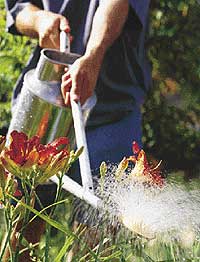 The traditional two-handled watering
can is designed to be balanced for
easy handling whether full or empty.
The traditional two-handled watering
can is designed to be balanced for
easy handling whether full or empty.
Long before hoses, spray nozzles, and sprinklers became standard weapons in the gardener's aqua arsenal, watering cans were the tool of choice. Elegantly styled and often ingeniously engineered, watering cans gave gardeners a reasonably effective way to supplement natural rainfall in the days before modern plumbing. Today, watering cans may not match the raw volume, power, and efficiency of high-tech hydrating gear, but cans do combine portability, precision, and a personal touch that no hose or sprinkler can duplicate.
continue reading below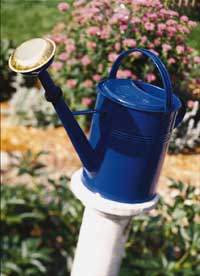 The larger the can, the fewer trips
back to your water source, but
water is heavy -- 1 gallon
weighs about 8 pounds.
The larger the can, the fewer trips
back to your water source, but
water is heavy -- 1 gallon
weighs about 8 pounds.
There's really not much to the average watering can. It's a round, wide-mouth vessel with a handle and spout attached. You fill the reservoir with water, tip the spout toward your target, and let gravity do the rest. Often, the spout's end is fitted with a rose, a perforated disk that converts the stream of water into a showerlike spray. From that basic design, variations in size, shape, materials, and color evolved to fit specific gardening needs and individual tastes.
How big a can you need depends on the job. Smaller watering cans, holding a few pints, are lightweight and narrow-spouted for use indoors or out on the porch, deck, or home's perimeter. They're particularly suited for hanging plants, window boxes, and other high-up or hard-to-reach spots. Larger watering cans, holding as much as 2 or 3 gallons, let you wander out into beds, borders, and the farther reaches of the garden without frequent refills. The 2- to 3-gallon size holds about as much water as most people can comfortably carry, but resourceful gardeners double their watering output by toting a can in each hand. Large cans typically feature two handles for tilting the heavier load without causing hand or arm strain.
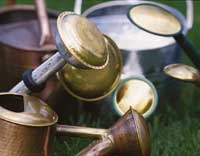 The round head on a watering can,
called a rose, comes in various sizes
to deliver different densities of spray.
The round head on a watering can,
called a rose, comes in various sizes
to deliver different densities of spray.
You can satisfy a lot of thirsty plants with 2 or 3 gallons of water but, by their nature, watering cans are suited to smaller jobs. Only gluttons for legwork would want to water an entire garden by hand on a regular basis.
A watering can is at its best when doing targeted work at the root zone, providing quick relief to containers and smaller beds, or bestowing a gentle shower on a particularly needy specimen. Hoses and sprinklers may be more efficient for watering larger areas, but they do take time to unreel, untangle, set up, turn on and adjust, and store away. Why drag a balky hose across the yard? With a watering can, you just pick it up and go.
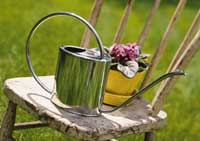 Strength and elegance combine in a
sleek, stainless steel watering can.
Strength and elegance combine in a
sleek, stainless steel watering can.
Precison is a watering can's other main strength. The stream from a hose or spray nozzle can be hard to control. A spray that's too powerful can wash away or compact soil and damage plants. Sprinklers often are spotty in their coverage: Invariably, some plants get more water than others, and a few may be missed entirely. Even when water hits the target, it may not make it down to the base of plants where it's needed. Container plantings are especially difficult to water with a hose or sprinkler. With all the splashing and spray, you end up wasting a lot of water.
A watering can allows you greater control. You can position the long, tapered spout right where water or liquid fertilizer is needed, reaching up to hanging pots or poking down to the soil at the base of densely planted beds. A plain spout permits a steady stream of water, whereas a rose attachment delivers a light spray that's gentle on plants and soil. Different sizes and shapes of roses offer different flow rates. Many roses are detachable and adjust for an upward or downward spray.
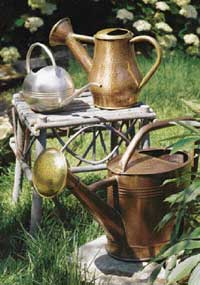 Traditionalists prefer the look and feel
of metal watering cans, like these
made of zinc, copper, and brass.
Traditionalists prefer the look and feel
of metal watering cans, like these
made of zinc, copper, and brass.
Performance aside, the look and feel of watering cans is appealing. Garden hoses and sprinklers look utilitarian; watering cans have character and personality. And you can pick a shape, finish, and color that fit your style. The silvery gray of steel dipped in zinc is a traditional choice, but powder-coat paint finishes provide brighter, glossier hues, such as reds, yellows, and greens. Copper, zinc, and stainless steel offer elegant variations in sheen and texture. Purists prefer metal watering cans for good looks and longevity, but practical gardeners appreciate that plastic versions are lighter, less expensive, and rustproof.
Regardless of how pretty or practical they may be, watering cans will always be popular for the personal touch they bring to gardening. When you step close enough to a plant to water it with a can, you're also close enough to inspect its health, inhale its aroma, feel its texture, and appreciate its beauty. Providing plants with personal watering attention would seem to quench a certain thirst in the gardener as well.
Copyright © www.100flowers.win Botanic Garden All Rights Reserved